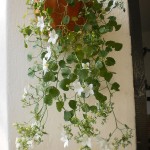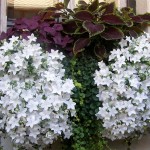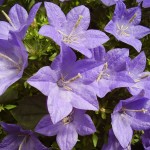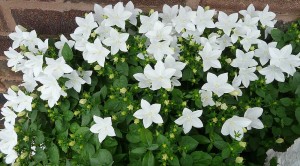Family: Campanulaceae
Distribution and habitat: Campanula isophylla is a perennial species found only on the cliff of Capo Noli, in Italian Alps. In their natural habitat, they grow like a trailing carpet over south-facing rocks. These plants have become popular pot plants in the Scandinavian countries, making excellent basket plants.
Description: Campanula isophylla is an easy to grow flowering trailer indoor plant. Its small, heart shaped, tooth edged leaves are bright green and rather brittle. If stems or leaf stalks are broken they exude a milky white sap with a distinctive, but not unpleasant, odor. Star-shaped, cupped flowers, which are produced from the leaf axils, are 4-5cm (1.5-2 inch) wide and pale blue.
The many slender stems, each as much as 30cm (12 inch) long, will trail down naturally or else they can be trained upward on a small trellis. Flowers, which are normally produced between midsummer and autumn, continue in succession for two or three months, usually becoming so numerous that they hide the foliage. Single flowers last 3-4 days.
Campanula isophylla is a perennial, though often is grown as annual.
Houseplant care: Remove spent flowers ofCampanula isophylla plants - which can be pinched off with the fingertips - in order to prolong the flowering season.
Campanula isophylla are fast growing plants and will last many years, but need special care to survive the winters. Cut back the long stems close to the potting mixture as soon as winter approaches.
They tend to trail or hang, but if it is provided support for the trailing stems with a frame or a trellis or if their stems are tied to thin canes, these plants can be encourage to a more upright habit.
Light: Although these plants do not require full sunlight, they should have bright light, ideally with some direct sunlight at all times. This should ensure close growth and abundant flowers. Campanula isophylla can bloom reasonably, well in a sunless window but only if they are stood on the sill.
Campanula isophylla are long day plants and need about 15 hours of daylight before flower buds will develop. Supplementary artificial light can induce the plants to bloom a little earlier in summer.
Temperature: Since flowers fade quickly in great heat, indoor Campanula isophylla should be given the coolest position possible in summer. In temperatures above 18C (64F) provide high humidity by standing plants on trays of moistened pebbles and mist-spray them regularly; this will help prolong the flowering period. In winter these plants should rest in a very cool temperature - ideally around 4C (39F) and certainly not above 10C (50F), the rest may be started as soon as flowering finishes. Higher winter temperature will curtail the next flowering season.
For optimum flowering avoid draughts and temperature changes.
Watering: Campanula isophylla like to have moist roots. During the active growth period and for the duration of the lengthy flowering period, they should be watered plentifully, as much as necessary to keep the potting mixture thoroughly moist - but never allow pots to stand in water. Even during the winter rest period these plants should be given some water - enough to moisten the potting mixture - at approximately two-weeks intervals.
Feeding: Apply standard liquid fertiliser once every two weeks, beginning when plants have filled their pots with roots (about six weeks after potting) and continuing until the flowering season ends.
Potting and repotting: Use a soil based potting mixture. For best effect, plant three or four rooted cuttings in a single 8cm (3 inch) pot in early spring; move them into slightly larger pots whenever roots appear on the surface of the potting mixture (normally, every two or three months). Maximum pot size require; probably 13cm (5 inch). To fill hanging baskets, take several plants from a few 8cm (3 inch) pots at the time they need repotting. Since blue and white varieties bloom simultaneously , they can be effectively mixed together in one basket.
Gardening: Campanula isophylla is generally not a difficult flower to grow. Being native to the temperate zones of the northern hemisphere where it grows in moist soil of montane regions, it require exposure to light and airy conditions.It is a non-invasive plant and generally tidy when not in flower. Also this plant ca be grown well in pots. It is a tender perennial ideal for a hanging basket or container that is outside in summer but brought undercover when frosts are likely.
Position: Plant them in a bright place but away from direct sunlight. The delicate flower colours are preserved best in shade. This plants can be planted under direct sunlight as long as they are generously watered.
Soil: Campanula isophylla plants enjoy a rich, well draining, light soil. Add lime if the soil is acid.
Irrigation: Campanula isophylla plant need constant moisture during the active growing season.
Fertilising: Water soluble fertilizers are generally used every two weeks during the growing season or per label instructions. Controlled, slow-release fertilizers are worked into the soil usually only once during the growing season or per label directions.
Propagation: Take 5cm (3 inch) long tip cuttings (each with three or four pairs of leaves) from old plants just as new growth appears in early spring; handle them gently so as not to break brittle stems and leaf-stalks. Dip cut ends in a hormone rooting powder to seal them and assist rooting. Gently insert each cutting about 1cm (0.4 inch) into a moistened equal-parts potting mixture of peat moss and coarse sand or a substance such as perlite, enclose the pot in a plastic bag and keep it warm in medium light. The cutting will root in two or three weeks and can then be moved into standard potting mixture for adult Campanula isophylla. After another three or four weeks of medium light and only moderate watering, the young plant can be subjected to brighter light and treated as a mature Campanula isophylla.
Propagation can also be achieved by divining established plants, but division is less satisfactory than the tip cutting method because stems of divided plants are old and always appear rather woody. If plants are divided, the clump should be pulled apart into several sections and gently shaken free of most of the old mixture. Fresh potting mixture is important for the health of the new plant.
Problems:
Campanula isophylla like plenty of moisture, but fungus diseases sometimes occurs if the soil retains too much water or if the plant is kept in excessively humid conditions.
Treatment: If this happens, a proprietary fungicide will kill the fungus, but the plant obviously needs drier soil and air in order to keep the disease from recurring.
Leaves turn yellow and shrivel. This is usually due to lack of water, light, or nutrition.
Treatment: Keep these plants evenly moist in summer, provide them with good light and feed them fortnightly.
Long flowerless trailing stems are probably caused by excessive heat.
Treatment: Keep Campanula isophylla plants out of hot direct sun.
Aphids are occasionally a pest on Campanula isophylla plants.
Treatment: Apply a suitable insecticide.
Glasshouse red spider mite, slugs, snails or vine weevil may attack these plants.
Treatment: Use an adequate pesticide to combat these pests.
Leaf spot, powdery mildew or rust are the disease that may infest these plants.
Treatment: Adequate treatment with fungicide used as recommended on their labels.
Recommended varieties:
Campanula isophylla f. alba is a white-flowered form.
Campanula isophylla 'Mayi' has hairy, variegated foliage and slightly darker blue flowers.
Companion plants: Campanula isophylla is looking best in landscape when planted along with dwarf conifers, alpines, acers, rhododendrons, bulbs, pines, lilies and South African bulbs and seed.
Uses and display: Campanula isophylla is and ideal plant for use in hanging baskets and raised pots. Alternatively, they can be trained upward on a small trellis. Also, Campanula isophylla plants are good in rock gardens in filtered shade. These plants deserve special settingsclose-up situations in rock gardens, niches in dry walls, raised beds or containers. As they are trailing kinds are ideal for hanging pots or baskets and wall crevices; vigorous, spreading growers serve well as groundcoversfor small areas on slopes in mild-winter climates.
Flower-filled baskets can be brought into the living-room window, or flower-covered pots can to used as centerpieces or in table-top compositions.
SUMMARY:
CHARACTERISTICS:
Foliage green
Features - flowers
Shape climbing and trailing
Height: 30cm (12 inch)
PROPER CARE:
Watering in rest period sparingly
Watering in active growth period plentifully
Light bright
Temperature in rest period min 4C max 10C (39-50F)
Temperature in active growth period min 16C max 21C (61-70F)
Humidity high
Hardiness zone: 5-8








